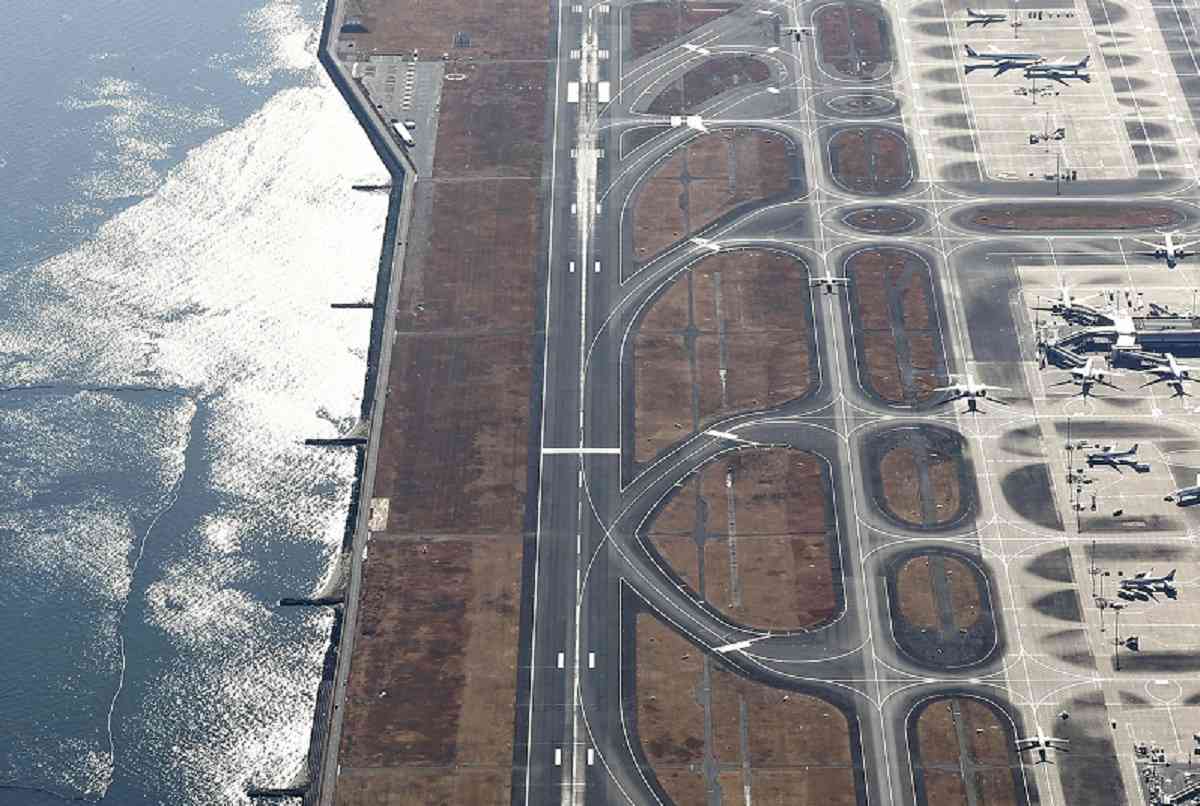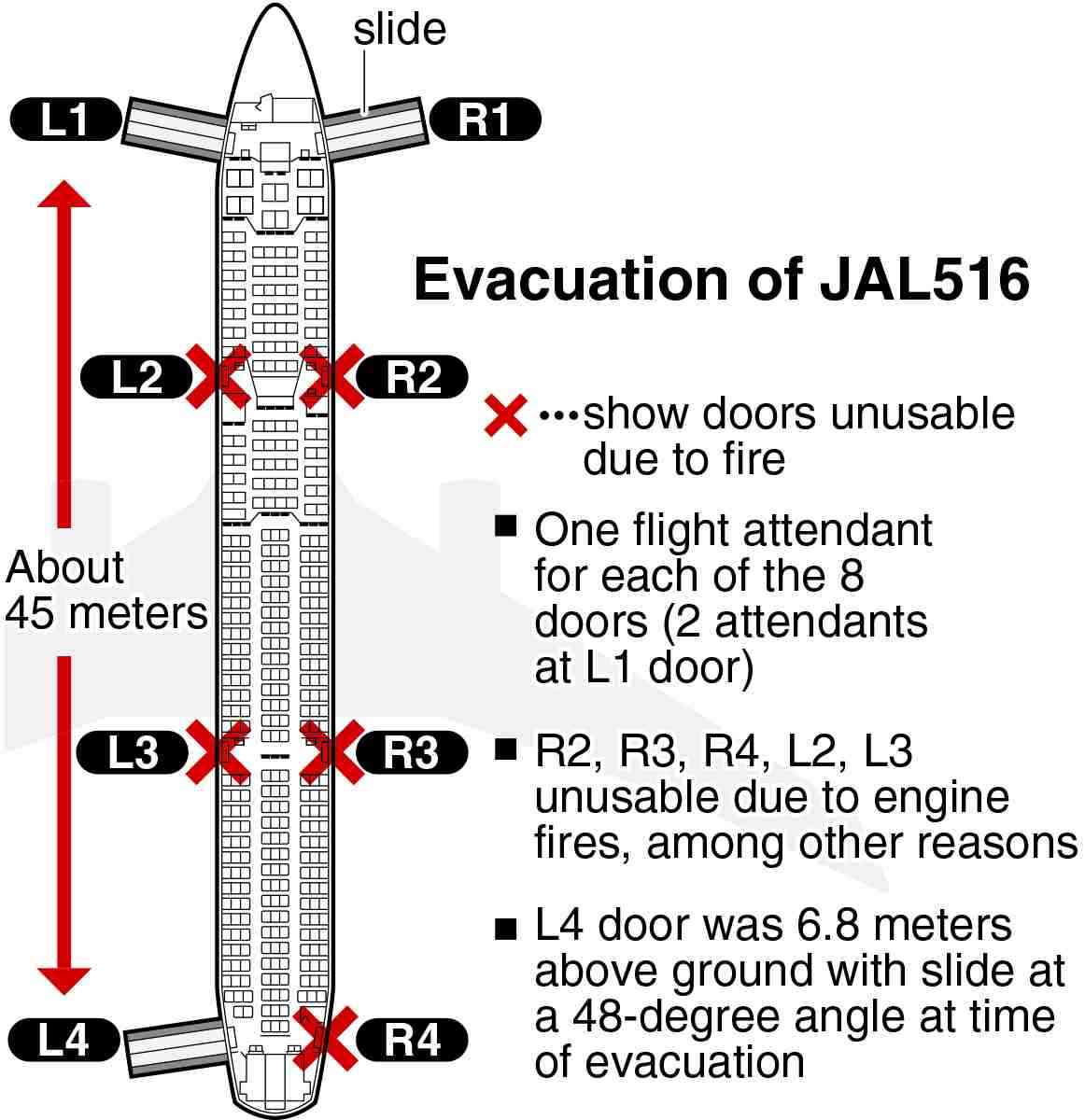JAL Looks to Improve Training with Lessons Learned from Miraculous Evacuation at Haneda Airport

Runway C is seen at Haneda Airport on Jan. 2, 2025.
21:00 JST, January 3, 2025
Thursday marked one year since a Japan Airlines plane and a Japan Coast Guard aircraft collided on the runway at Haneda Airport.
An investigation by the Japan Transport Safety Board showed that the miraculous escape of all 379 people onboard the JAL plane was thanks to several coincidences, and that events could have easily gone another direction. Airlines such as JAL are now incorporating lessons from the accident into their evacuation training.
“Although there was no major damage to the cockpit or passenger cabin, people could have suffered more harm if conditions had been different,” a progress report by the JTSB, released on Dec. 25, said of JAL Flight 516.
According to the report, the JAL plane collided directly with the back of the JCG aircraft at a speed of 222 kph. The impact damaged the electrical room under the JAL plane’s cockpit, causing problems with the electrical, steering and braking systems. In JAL’s internal documents, the plane’s captain and others testified about the situation right after the accident, saying that they had attempted to use the brakes, the rudder and the steering for the front wheels but they didn’t work, and they found the plane to be “uncontrollable.”
At the time of the collision, the aircraft’s front tires were not touching the ground yet, and its nose was pointed up at a 3.5-degree angle, which meant the cockpit narrowly avoided being hit by the JCG aircraft’s tail due to the small difference in height. The 17-meter-high Airbus A350-900 passenger plane then rode up onto the JCG aircraft’s body and passed over it.
A captain from a different airline who pilots a 12.5-meter-high midsize aircraft said: “If it had been my aircraft, it would have crashed into the body of the JCG plane and broken up, causing serious injury to passengers and crew. It was lucky the JAL plane was so large.”
After the collision, the JAL aircraft rolled 1,400 meters along the runway and 300 meters on grass before coming to a stop in a forward-leaning position. Had the plane rolled onto its side or back, there would likely have been more harm to those on board. The rear landing gear also stayed intact and, along with the malfunction of the control and braking systems and the thrust reversers, this is believed to have helped the aircraft maintain its balance.

Doors opened
The report also presented a clearer picture on how the passengers were evacuated.
The JAL aircraft came to a stop at 14 seconds past 5:48 p.m. Fire broke out around the rear landing gear compartment in the middle of the plane as well as in both engines, which sucked in fuel from the JCG plane. The left engine had a severe fire, and the right engine, which did not stop despite the captain’s attempt to shut it down, continued to spew flames out its back.
In the pitch-black cockpit, the captain immediately decided to carry out an evacuation, but the in-flight announcement system, another system for evacuation directions and the intercom did not work, so he gave instructions directly to flight attendants at the front of the cabin.
Thirty seconds past 5:51 p.m., evacuation began through the L1 and R1 doors on the left and right sides of the front of the cabin. These were two of the eight cabin doors. However, the instructions to evacuate did not reach the rear of the cabin, and a white smoke with an irritating odor was gradually getting thicker, making it impossible to see more than a few meters ahead in the center of the cabin.
The instructions never reached the L4 door at the very back of the cabin, 45 meters from the L1 door.
As the situation grew more urgent, a 48-year-old cabin attendant made a decision to open the L4 door, believing it had to be done to save the passengers. After confirming there was no fire or fuel leak, the door was opened, and the escape slide was lowered. This action was taken at around 5:55 p.m.
Some of the passengers, including those of foreign nationalities, did not hear the instructions and kept following the initial instructions to “stay in your seats with your heads down.”
The captain found the trapped passengers in the smoke and, after they were all out of the plane, he became the 379th and last person to evacuate, through the L4 door, at 5:58 p.m. Two minutes later, flames and black smoke spread through the cabin.

In response to the accident, JAL has included a scenario in its fiscal 2024 comprehensive training in which communication between crew members becomes impossible, while further stressing that passengers can take no carry-on luggage with them, an instruction that helped crew evacuate passengers quickly during the accident.
All Nippon Airways Co. has also analyzed the accident independently and conducted practical joint training for pilots and flight attendants, with a renewed focus on such situations as when the cabin is dark, there is fire and smoke, there is a breakdown in communications, or there are no instructions to evacuate.
"Society" POPULAR ARTICLE
-

M4.9 Earthquake Hits Tokyo, Neighboring Prefectures
-

Israeli Tourists Refused Accommodation at Hotel in Japan’s Nagano Pref., Prompting Protest by Israeli Embassy and Probe by Prefecture
-

M7.5 Earthquake Hits Northern Japan; Tsunami Waves Observed in Hokkaido, Aomori and Iwate Prefectures
-

Tsukiji Market Urges Tourists to Avoid Visiting in Year-End
-

High School in Kyoto Says Students Shoplifted during Recent School Trip to Bali, Indonesia
JN ACCESS RANKING
-

Tokyo Economic Security Forum to Hold Inaugural Meeting Amid Tense Global Environment
-

Keidanren Chairman Yoshinobu Tsutsui Visits Kashiwazaki-Kariwa Nuclear Power Plant; Inspects New Emergency Safety System
-

Imports of Rare Earths from China Facing Delays, May Be Caused by Deterioration of Japan-China Relations
-

University of Tokyo Professor Discusses Japanese Economic Security in Interview Ahead of Forum
-

Japan Pulls out of Vietnam Nuclear Project, Complicating Hanoi’s Power Plans























